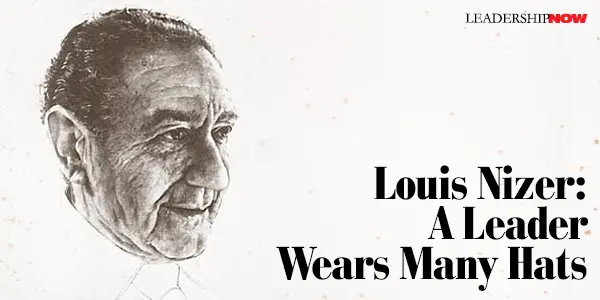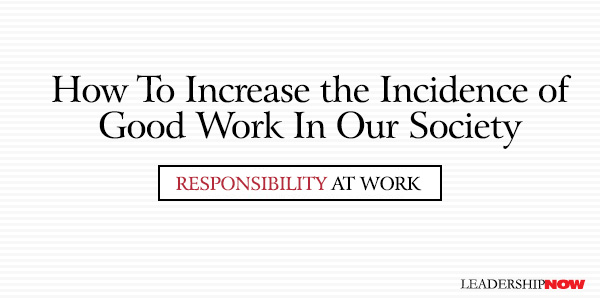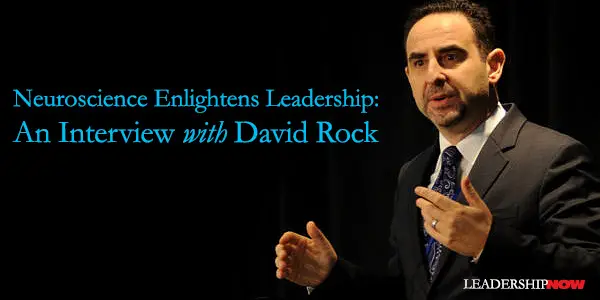 Leading Blog | Posts by Month |
 Leading Blog | Posts by Month |
08.31.07

You Can Change!
WHEN we take personality tests we need to understand that they are snapshots not indictments. They are a point to grow from. It’s easy to confuse behavior and personality. Personality is reflected in behavior. But, behavior can be changed. One may be especially competitive. However, one need not be boorish or rude. In a recent TeleForum presented by LeadingNews, Marshall Goldsmith, author of What Got You Here Won’t Get You There, stated that personality testing can lead to stereotyping. To say my personality type is this and is unchangeable is wrong thinking. Executive coaches that believe that people can change are much more effective than executive coaches that do not believe people can change. This may seem like a “Duh!” moment, but it is surprising how many people talk about personality testing as though people cannot change. If you don’t believe people can change, coaching is the wrong business for you to be in. Goldsmith commented on a common misconception surrounding the new emphasis we now see being placed in the build-on-your-strengths movement. The idea of building on your strengths is an effective life strategy but not an excuse. He stated: The build-on-your-strengths idea makes total sense when it’s at the level of the occupation. For example, Tiger Woods should be a golfer, not a stand-up comedian. He’s building on his strengths becoming a golfer and he shouldn’t be a stand-up comedian. On the other hand, I think what happens on the build-on-your-strengths stuff, is people misinterpret it. So they would say, “Well, Tiger Woods is a great driver, so he doesn’t have to worry about putting. He can ignore his putting.” He really cannot ignore his putting. It’s part of his job. If you’re a leader and you’re great at strategy but terrible with people, you can’t just sit there; if your CEO, and say, “It doesn’t matter.” It does matter. It all matters. You can’t sit there an ignore part of your job and say “I’m not good at that, therefore, I have an excuse to ignore it.” All that does is reinforce a useless stereotype. While most advocates of build-on-your-strengths do not encourage that, Goldsmith is right. The idea is often misinterpreted. We must build on our strengths and minimize activities that call upon our weaknesses, but our weaknesses have to be dealt with. And that requires some behavior modification. Too often it can be taken an excuse to do-your-own-thing and not a position to grow and learn from. We can’t let ourselves fall into the trap of saying, “That’s just the way I am” because it’s hard to change. It may be the way you are, but you can be better. You can grow if you decide to. As a leader, you have an obligation to. Mark Sanborn said in a recent interview that he thinks most of us “sell ourselves short in terms of the impact that we can have in the world or in the marketplace, or in our homes and communities. We all have the opportunity, and maybe to a degree, an obligation, to take whatever talents we've been given and develop them to the fullest, so that we can more positively benefit and contribute to others.”
Posted by Michael McKinney at 09:20 AM
08.29.07

Max DePree on the Good Work of LeadershipMax DePree reminds us in Leadership Jazz that developing one’s leadership just in terms of corporate or institutional needs is not enough. Leaders need to be developing the whole person; polishing all of their gifts. He writes, “Leaders deal in substance and the quality of life, deaf to the calls to pursue quantity and appearances.”Polishing our gifts isn’t something we should try to do on our own. Nor is it just about us. It’s also about the people around us. The process first requires that we have an accurate view of ourselves to know who we are and what we believe in. One question DePree asks himself is “What do my family and I need to cultivate to reach our potential?” It becomes a process of broadening and deepening ourselves and through us, those close to us. “Good leadership includes teaching and learning, building relationships and influencing people, as opposed to exercising one’s power.” He suggests the following activities:
Posted by Michael McKinney at 08:55 AM
08.27.07

5 Leadership Lessons: Measure of a Leader Aubrey and James Daniels wrote a comprehensive and thoughtful book on leadership entitled, Measure of a Leader. It is a book that deserves far more attention. The premise is a new model of leadership that focuses on the behavior of followers. By becoming a better observer of human behavior we can become better leaders. They say that “most leadership writers limit their premises to the success of the leader at his or her particular venture.” There’s more to it than that. How you accomplish something is as important (if not more important) than what you accomplish. Here are a few lessons from their book:
Posted by Michael McKinney at 10:48 AM
08.24.07

Louis Nizer: A Leader Wears Many Hats

It took as much energy to unify our comrades as to prepare our own brief. A lawyer, particularly when he deals with eminent co-counsel, whose talents and achievements warrant strong egos, must be a consummate diplomat. Those words cause me to take a step back. Any leader would be strengthened by applying these concepts in their own arena. 
Posted by Michael McKinney at 09:18 AM
08.22.07

Fast versus Busy in the Age of SpeedSpeed aficionado Vince Poscente says we are looking at speed from the wrong perspective. While living in a more-faster-now culture can be a little daunting, it also has the power to enrich our lives by making room for more significant things. In The Age of Speed he writes, “When we harness the power of speed, we not only get more and get it faster, but our lives and work become less stressful, less busy, and more balanced.” Crazy idea you say?We like speed when we’re demanding it. We are not so fond of it when it is being demanded of us. You can’t have it both ways. If we want speed, we also have to deliver it. Poscente says though, that it doesn’t necessarily mean that we have to be buried under more work, more responsibilities and more demands. We actually can do more in a given time than we could even five years ago. Therefore, the expectations we face to produce faster are often valid. But we don’t have to work harder or work longer hours to accomplish more.“So,” Poscente asks, “why do people become irritated and rail against the expectation to speed up?” Here’s the key: Perhaps it’s because we don’t often use the extra time for more rewarding experiences. Frequently, when we reduce the time it takes to do something insignificant, we end up using the saved time on yet another insignificant activity. If you figure out a way to save time at the bank and the grocery store, for example, do you earmark that time for something more rewarding, or do you just fill that time passively with other responsibilities that pop up? The latter scenario would leave anyone feeling exhausted, burnt out.I think we have all been guilty of that. He explains: Speed is a great solution for increasing income and productivity, but those benefits are only one piece of the picture. The bigger reason we should speed up is to make time for meaningful experiences. Speed is not just the way to get more work done—speed is the secret to having time to do what we want.Poscente say we can speed up and still have the time to smell the roses. We need to know when speed will and will not benefit us. Are there ways you can approach what you do in a different way that would allow you to spend more time with your priorities, strengths, talents, and passions?
Posted by Michael McKinney at 10:46 AM
08.20.07

The Power of Thinking TwiceHuman freedom involves our capacity to pause, to choose the one response toward which we wish to throw our weight.Les Parrott claims that “three seconds separate those who ‘give it their all’ from those who ‘don’t give it a thought’ — literally. Three seconds. This brief buffer is all that stands between those who settle for ‘whatever’ and those who settle for nothing less than ‘whatever it takes.’” In his book, 3 Seconds: The Power of Thinking Twice, he presents six impulses that never pay off. The impulse to … Give up before trying . . . because we feel helpless. Shun a challenge . . . because it seems daunting. Settle for the status quo . . . because we lack vision. Shirk responsibility . . . because it’s easier to shift blame. Do the mere minimum . . . because that’s all that’s expected. Avoid taking action . . . because we fear failure. If we routinely don’t give any one of these a second thought, they can lead us to lives of mediocrity. From Parrott’s perspective, it comes down to taking a moment to leverage the three seconds it takes to decide whether to behave in a manner consistent with what you really want or to give in to one of these self-sabotaging impulses. Fundamental to all of this is taking personal responsibility. “And many times, you have to shoulder the blame, not because you personally did anything wrong, but on behalf of the company. The best way to do this us to focus not on who’s wrong, but on what’s wrong.” Taking ownership for something often involves an apology. But a simple “I’m sorry” will sound hollow unless you’ve taken the three elements of an apology into account. First, you’ve got to understand what’s wrong. Get what’s wrong right. Second, you then have to admit to it. “Don’t make anyone drag an admission of what’s wrong out of you.” Finally, you need to rectify the situation. You need to do something to try to make the situation better. I would add that not all wrongs can be righted. Nor should we expect them to be. It is a very inward-directed individual that always demands their pound-of-flesh.
Posted by Michael McKinney at 09:08 AM
08.18.07

Business Leaders Have Much to Learn From Orchestras, says Nestle CEO Peter Brabeck-Letmathe
Posted by Michael McKinney at 08:14 PM
08.17.07

How To Increase the Incidence of Good Work In Our Society
Ever since Adam and Eve were expelled from the Garden of Eden, human beings have had to work “by the sweat of our brows.” For most of human prehistory and much of recorded history, work has not been an activity on which we have had much perspective. Howard Gardner continues, “If we are to have a society that is open and fair, individuals must willingly, even energetically, be prepared to carry out crucial actions—ones required for the achievement and maintenance of such a society.” This sets the stage for his book, Responsibility at Work. The book of basically a collection of reports on the GoodWork® Project. Began in 1994 by Mihaly Csikszentmihalyi, William Damon, and Howard Gardner, the GoodWork® Project seeks to determine how best to increase the incidence of good work in our society. From the reports given, Gardner lists seven widely applicable takeaways:
Gardner gives an important caution, one that needs wider attention. “Recognizing the complexity of ethics is not the same, however, as embracing relativism. That the answer is not always clear-cut or that judgments may be controversial is scarcely a license for ‘anything goes’.” Extremely well put. At the expense of making this post a little long, let me give you a couple of other thoughts from the book: William Damon and Kendall Cotton Bronk contributed: “A critical component of [Max] De Pree’s philosophy on leadership was accountability. Leaders, he believed, should have enough faith in their workers to allow those workers to be personally accountable for the work they do. “De Pree had a series of mentors who helped him see his work in a broader context. In our interview, he talked about the important role that ethical businesses play in the support of the societies they serve. ‘I think that my business career was kind of pilgrimage away from, you know, how you can build up the revenues . . . towards a goal of figuring out what are the preserving principles of the free market system in a democracy.’ Mentors helped De Pree connect his work life to his religious life. They helped him see how his work life could serve society and, in doing so, serve his religious aims as well.” And finally, again from Gardner: “Professions need to respect their current instantiation but not be paralyzed by it. Change for change‘s sake is rarely indicated, but reflexive adherence to the status quo is equally problematic. Those professionals and professions that keep their principle values and goals centrally in mind are the ones most likely to thrive; they can peer through accidental changes in methods of delivery while making certain that the most important needs and desires are being appropriately fulfilled.” 
Posted by Michael McKinney at 09:48 AM
08.15.07

It's Not About Me?!?In The Ring in the Rubble, Gary Brandt brings up something that can hold us back from defining our problem, immobilize us, and block us from finding solutions. We tend to think that what we see is reality, and to forget that there is a much bigger world out there that, if we considered it, would put our situation into perspective. When we forget this, we tend to take our own perspective a little too seriously, and in the process, we take ourselves too seriously as well.Brandt suggests that a well-developed sense of humor makes a good antidote.
Posted by Michael McKinney at 08:25 AM
08.13.07

Dilenschneider: Power and Influence
PUBLIC RELATIONS guru Robert Dilenschneider’s excellent new book, Power and Influence: The Rules Have Changed, is worth your time because it is filled with a lifetime of wisdom about how to get along with others—a skill that is at the heart of leadership. He presents ten rules to think about and apply variously to your own situation. I think the most important ideas coming from these rules revolve around how to adapt to your changing world and situation, the importance of knowing how to be relentless, and the need for civility and humility. Rule Four is Seize the Opportunity in Every Crisis. All of us experience some crisis of one form or another, at any given moment in our lives. The big question is how we handle it. Dilenschneider writes, “The ability to survive in an uncertain time is critical…. [A] big part of power lies in knowing the moment to move. It’s not being all over the place all the time; it’s knowing that one critical instant to move, taking action, and getting the result.” He asked his friend, power player Alan Goodman how he viewed power players and their ability to respond to a crisis: They are not impressed with power, and they are not concerned with power. They are concerned with ideas and impact. To me, that’s the biggest lesson I’ve learned from the people I’ve met. Their focus, and the focus of any of us that are lucky enough to lead an institution, has got to be what you do with it. How you make the world less dangerous, how you make your community a better place, how you energize people to get their ideas, because you don’t have all the ideas yourself. The best leaders focus on getting the best ideas and then doing something with them. Here are a few other lessons from Dilenschneider: LESSON: For a power player, it’s important to reach out to the shoeshine boy as well as the CEO. In fact, sometimes it’s more important to reach out to the shoeshine boy so that the CEO sees that you’re a person of the people, a person who’s generous, who’s humble, who’s willing to do outreach. LESSON: What is it like to be with these men and women of power? With the best of them, it is terrific because they are essentially humble people who understand their own shortcomings. LESSON: Keep your friendships, nurture them, and don’t expect anything in return. At the same time, when someone else has a problem, help that person instead of shying away from him or her. Most people tend to look at people with problems and say, “I want to avoid those people.” The time to go to people is when they’re down and out. They are unlikely ever to forget your goodwill. 
Posted by Michael McKinney at 10:58 AM
08.10.07

What Should I Be Thinking About?
MARK SANBORN (author of, among other things, You Don't Need a Title to be a Leader) wrote a good post about digging a little deeper to find those things to think about that will really make a change in our lives. We often don’t give attention to those things that have become familiar to us. Familiarity breeds contempt, and so we tend to gloss over those things in search of the big thing. In actuality, it is the little everyday life issues that, when acted upon, will have the greatest long-term effect on our life. Sanborn challenges us with an important question: “What in my life that I can influence or control should I be giving serious thought to today? That would include things like relationships, family issues, financial planning, career choices, health and exercise, and one of my favorites, the difference between activity and accomplishment.” He adds, “The agenda set by print and broadcast media don’t always focus us on what we need to be thinking about. The only person who can determine the appropriate thinking agenda for your life is you.” 
Posted by Michael McKinney at 04:12 PM

Letting Go of Worry About the Future and Resentment From the Past
GARY BRANT asks us in his book The Ring in the Rubble, to look at how we are perceiving change in our life. He writes that “change is the great equalizer; it affects all of us. Organizations that view change as an opportunity and aggressively seek to find and capitalize on it, win. Those who don’t fall behind and are doomed to forever play catch-up. “This applies to your personal life as well. Whether you’re facing a new marriage, divorce, birth, death, or illness, it’s not the change itself that dictates the results we get, it’s how we perceive and handle that change that makes all the difference."For his metaphor, “the ring represents the valuable opportunities that change always creates. The rubble symbolizes the disruption, fear, and uncertainty that change almost always stirs up. My goal is to help you find the rings in the rubble of whatever changes you face, both at work and at home.” Our perceptions of events in our life are based on how we view our world – our attitude. Sometimes our attitude is based in reality, but you would be surprised how often it is not. Often these false assumptions block us – and our organizations - from seeing things as they are and advancing to our full potential. Brant asks a series of questions to help us get at the emotional issues of regret and worry that are holding us back from taking positive action that is worth reviewing from time to time:

Posted by Michael McKinney at 09:03 AM
08.08.07

Rick Warren: 5 Steps to Leading Change
IN a Christianity Today Leadership Journal interview with Rick Warren, he made some observations about renewal and change that apply to any organization (and really individual change as well). He has found that we go through five renewals and typically in the following order: 1. Personal Renewal This gets at a renewal of the heart—knowing yourself and getting your values, priorities, and purpose straight. The first step of any leader is to first get themselves right. Of course, this is a lifelong cyclical process. You never get it right and move on. It should happen concurrently with everything else you do in your life. 2. Relational Renewal Warren says, “It’s loving your neighbor as yourself.” A leader can’t lead unless they have a solid, honest relationship with their people. Getting your attitude right about other people—how you value and respect others—is foundational to effectively leading others. It comes out in many ways and will affect how people react to your message. 3. Purpose Renewal What am I supposed to be doing? Where are we going? We are not here just for ourselves. “We have work to do.” 4. Structural Renewal Warren says, “You can’t put new wine in old wineskins. I once asked Peter Drucker, who was my mentor for over 20 years, ‘How often do you have to change the structure in a rapidly growing organization?’ He said about every 40 percent growth. (Now, since that time, I’ve heard him use two other numbers, so I think he was just making it up.) But the point is that structural renewal happens pretty often.” To sustain the change you need to structure everything you do so as to guide your behavior to be in alignment with your values, attitudes about other people, and your purpose; why you do what you do. 5. Cultural Renewal The first four renewals eventually become the catalyst to make the change or renewal part of our thinking and thus our behavior. We become what we say we are.
Posted by Michael McKinney at 09:09 AM
08.06.07

Quiet Sacrifice Leaders also understand the meaning of quiet sacrifice. This is something I have had to do several times in my career and will, I am sure, have to do again. Well put. Nothing great comes without costs.
Posted by Michael McKinney at 06:51 AM
08.03.07

Neuroscience Enlightens Leadership: An Interview with David Rock
AS research into the mind develops, we will see it being applied to more and more areas of human behavior. Most recently, international business consultant David Rock applied it to the art of leadership and coined the term neuroleadership. Neuroleadership uses neuroscience to inform the art of leadership. Some have confused it with some sort of science fiction brain research that attempts to recreate the perfect leader’s mind. Combining an art with a science has its limitations. There is the idea that when applying a science to the study of any area, including leadership, one can make it as mechanical as possible. This is rarely the case. There are no shortcuts to leadership, but there is the hope that neuroscience can enlighten our understanding and add substantially to the form of best practices in leading people. We talked to David Rock to try to gain a little insight into this new field of study. LeadingBlog: To begin, what is neuroleadership? David Rock: Neuroleadership is the study of leadership through the lens of neuroscience. Neuroleadership explores central elements of leadership such as self-awareness, awareness of others, insight, decision making, and influencing, and applies what we are learning about the brain in these instances, thus building a neurological theory base for the “soft skills.” The field is not attempting to measure leaders' brain waves to find the “secret” of great leaders.
David Rock: Correct. It's more like scientists running around saying, 'what is going on in the brain when someone solves a complex problem through insight, and how can we, therefore, increase leaders' abilities to have or facilitate insights'. As we better understand the mechanisms involved in everyday leadership activities, better leaders may emerge, but it won't be through brain transplants or the direct use of technology. The technology, like EEG and fMRI, is there to test theories. LeadingBlog: What brought you to connect the two fields of study – neuroscience and leadership? David Rock: David Rock: I was personally trying to find the best science to explain the art of influencing people. “Getting people to do what you want” is still the hardest question for many people in business. I spent several years on this question, reading, writing, and teaching in this area. At one point, it became very clear that neuroscience provided the most coherent and complete explanation for what goes on when we try to drive change. I ended up writing a book on this (Quiet Leadership), then a paper (The Neuroscience of Leadership), both of which became popular. The NeuroLeadership Summit in Italy in May this year was the first test to see if there was really a field emerging here or just a few of us with this crazy idea. Based on the global response to the Summit it's clear that many people are hungry to bring more science into leadership development, specifically a “hard” science like neuroscience. LeadingBlog: What can we expect from neuroleadership? David Rock: Bear in mind it's early days, so expect it to take a few years for major findings to emerge. However, you can expect to see business schools globally building neuroscience into leadership programs; books written on various aspects of the field; science that explains how to be better at influencing, leading, training, learning. To start with, we need to do a lot of work at the level of one-to-one leadership, and as this theory base grows it will become more about the systemic application of the research. We will see research on every aspect of leadership, including change, engagement, incentive, feedback, presence, trust, teams, etc. LeadingBlog: Self-awareness is critical to leadership. The lack of it explains why we go off on tangents and end up with consequences we never intended. What is self-awareness from a neuroleadership perspective? David Rock: That's one of the main focuses of the field, understanding self-awareness in a new way. There is some excellent neuroscience being done on “active” versus “passive” brain processes. Active processes are ones which we are aware of; passive occur beneath conscious awareness. We need both, as passive processes are far more efficient, active processes work in serial and are very tiring. The neuroscience is showing that the concept of observing your own thoughts is central to our ability to choose between active and passive. Coined “the impartial spectator” by Adam Smith, without this ability, we are always to some degree on automatic. There is a specific part of the brain that lights up when we choose to step outside the flow of experience and observe behaviors and make a choice. So self awareness is not a soft concept, it has very real correlates in the brain, and it has an impact on how data is experienced and interacted with. There's a LOT more to say about this, of course. LeadingBlog: If I have been hardwired a certain way, can I change it? David Rock: Yes, we do all the time. The key is the brain only really goes forward; you can't go backward. You can't get rid of wiring you don't like. You can only create new wiring. That's because the process involved in change in any way requires attention - requires focusing your attention - and attention changes the brain. Attention creates or embeds circuits focused on. So we can change, but we need to learn to put our attention on new circuits not the old ones. That's often hard as old circuits are easier to bring attention to—there are lots of them—than newer more subtle circuits. It's like trying to find a car, versus a needle, in a haystack. LeadingBlog: Some don't come to self-awareness naturally. Is there a physical reason for it or is that strictly a function of environment and experience? David Rock: Some people haven't given it much attention, so their circuits aren't well developed. Others might be born with weaker circuits between emotions and words, which is a medical condition. There is very much a part of the brain that becomes active when we focus our mind on inhibiting mental signals; it's under the right temple in the brain. LeadingBlog: Can it be developed or improved? David Rock: We can improve self-awareness the same way we can improve our ability to speak a language, play tennis or learn PowerPoint. We need to pay attention, and activate the relevant circuits regularly. The good news is small regular efforts can do a lot: it’s the same way we quickly learn to do something even more complex, like learning to drive. LeadingBlog: From time to time, there is that moment when we "get it." There’s a breakthrough or a flash of insight. It is a moment when we experience a leap in learning. What can neuroleadership tell us about what is happening? David Rock: There are some great studies now on insight. We know that insight occurs when the brain goes quiet for a moment. We know that insight is a very important moment in the brain; it packs an energetic punch, and represents possible long-term changes in circuitry. Often we get an insight moment at surprising times, when we're doing other things. That's because the part of the brain we use actively, can drown out the signals from the rest of the brain. We know that anxiety decreases the likelihood of insight, and happiness and positive affect generally increases the chance of insight. LeadingBlog: How would this affect how we work with or teach others? David Rock: In so many ways! For example, when we start to value insight as the moment at the heart of change, we start to create ways of facilitating it. The great thing about the energy of insight, which is partly adrenaline, is that it drives people to take action. Insight engages people, it makes people get up out of their chairs literally and want to drive change. This is one important lesson from the science: insight is not helpful to long-term change, it's central to long-term change. But each person needs to have their own insight, not just listen to their leader's insight. LeadingBlog: Some of mankind’s biggest achievements have come by the rearranging of the old in a new way or seeing old concepts in new ways. It would seem that is what you are doing here. David Rock: Indeed. One of the best feelings in the world is when we see an existing situation in a completely new light. Making new connections between unexpected elements turns out to be a wonderful way of generating positive feelings in the brain too. It's what we do when we do a crossword puzzle, read a book or watch a movie. Neuroleadership is about helping leaders understand how their own and their people's minds and brains ACTUALLY work, replacing our current guesswork. Humans have a long history of incorrect assumptions about the world. We think for example, that rewards motivate people. Actually, it is anticipation of a reward that motivates, the reward itself does little. And the anticipation is closely linked to attention. We think that punishment drives change. Actually punishment or the threat of it focuses attention, and it’s attention that drives change. However, punishment can send attention to some less than helpful places too. So if we know that attention changes the brain, let's get better at understanding attention, instead of focusing so much on reward or punishment. When you look at attention, you see that it's very closely tied to our social world, then you begin to see just how much of an impact human beings have on each others' attention, whether we like it or not. So this is perhaps a whole new area to explore, which might have greater benefits than only studying the carrot and stick. And all this just comes from seeing that attention is the active ingredient in change. My point is, having a new frame of reference, as well as feeling good, may be more useful than we realize at first. LeadingBlog: The result of bringing these disciplines together is for leaders to gain insight on how to best help others to think better - for themselves. This would seem to be quite significant. David Rock: Leaders have established their own, often non-articulated, scientific theories for how people work. The science will help build leaders more accurate understandings of how we work, so we can become more effective at leading. Leaders are, after all by nature rational beings, and so they should be. This field provides a rational science to explain many things that are not being given enough attention in the workplace. By speaking to leaders and organizations about human issues, in the language that they are used to, we can hopefully improve how workplaces function. 
Posted by Michael McKinney at 09:10 AM
08.01.07

Leadership Books: August 2007Here's a look at some of the best leadership books to be released in August.




Posted by Michael McKinney at 09:10 AM
|
BUILD YOUR KNOWLEDGE


How to Do Your Start-Up Right STRAIGHT TALK FOR START-UPS 
Grow Your Leadership Skills NEW AND UPCOMING LEADERSHIP BOOKS 
Leadership Minute BITE-SIZE CONCEPTS YOU CAN CHEW ON 
Classic Leadership Books BOOKS TO READ BEFORE YOU LEAD |
|